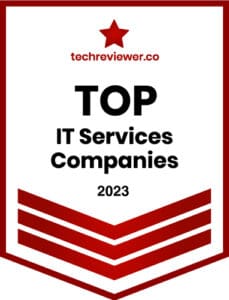Technology is starting to impact all of us in many different ways and at a rapid pace. Most of us feel it from the business side and in many different ways every day. Whether it’s bookstores, hotel chains or who we travel to, all of these things have completely changed.
For example, if you were in the S&P 500 in the 1920s, your company lasted on an average of about 67 years. Today the standard lifespan is 15 years. The era of people coming out of college and going to work for a company and saying, “Hey, I’ve got an idea,” are now walking out and saying, “I run a multi-billion dollar company.” From creating an app or some technology, selling it, and heading off to their next adventure.
It’s a very different reality from what many of us walked into, and we’ve seen it happen with all of these different types of businesses. The massive amount of change and exponential change has grown to the point where everything you see in this picture now fits in your pocket.

Everything you see in this picture, you can now do on your phone.
Let’s get real clear on what this means to you today in your business and what you might have to adjust for in the future. Typically to measure computing power or the computer’s ability to carry out calculations is by how many calculations per second can an average $1,000 laptop perform? In the early 2000s, processing power and computing power began to jump and reached the point where an average $1,000 laptop can carry out as many calculations per second as a mouse’s brain. But what’s about to happen is by 2023, a $1000 laptop will carry out as many calculations per second as a human brain. The way technology is unfolding right now will be up to 10 to the 26th power on calculations per second by 2015. That would be the amount of computing power if you strung all of the brains of the human race on earth together. That’s how much processing power an average $1,000 laptop will have in just a few years. That change is dramatic.
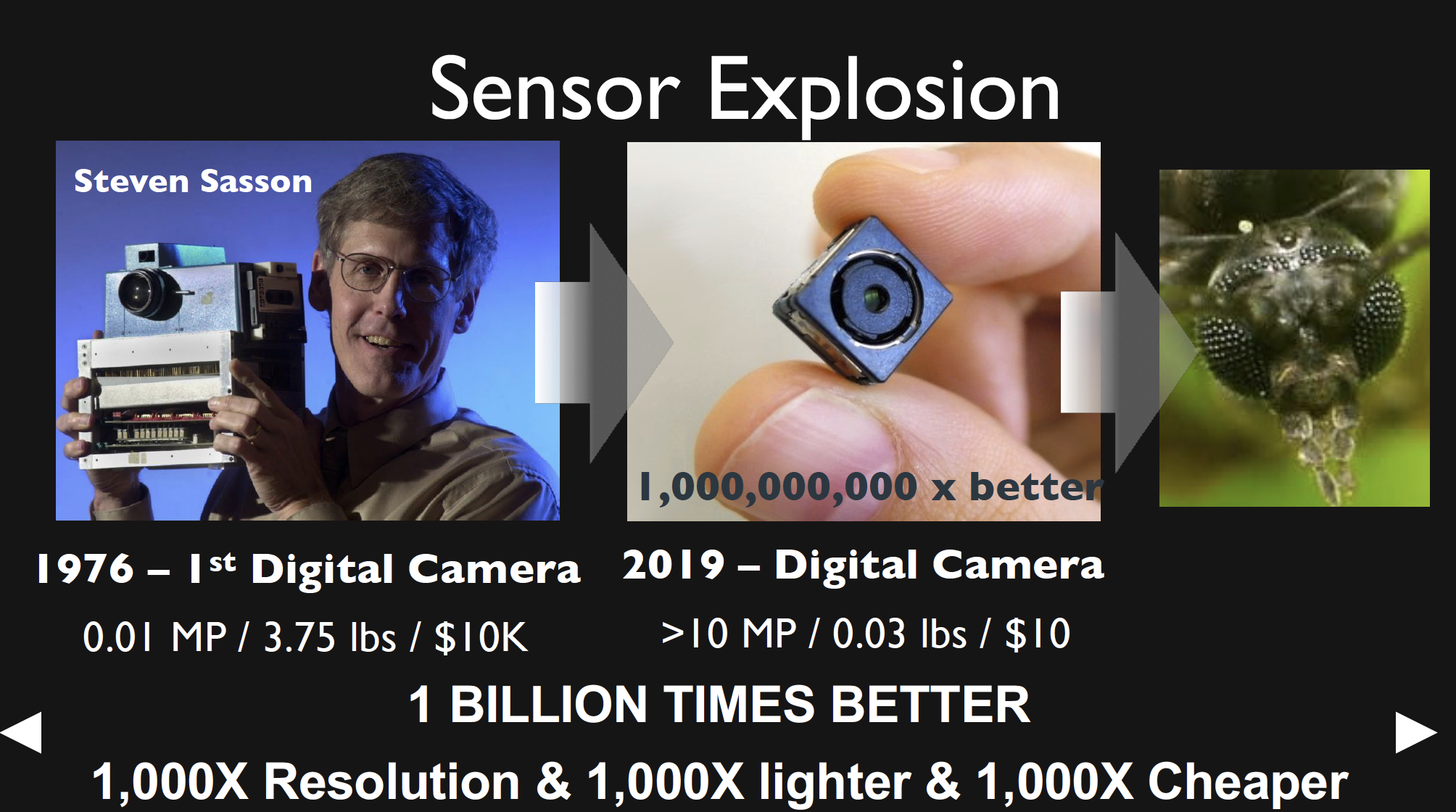
To put it in perspective, in 1976, Steve Sasson created the digital camera. It cost about $10,000, weighed nearly four pounds, and came with a massive one 100 megapixel in resolution.
Fantastic, right? In 2019, the digital camera was greater than 10 megapixels, weighed less than four-hundredths of a pound and cost about $10 to put in your phone. Making it a billion times better with a 1000 times better resolution, 1000 times lighter and 1000 times cheaper.
The same thing had happened from the space program in the 60s when they created this internal inertial measurement unit, which measured velocity and orientation and acceleration. That may not mean a whole lot to you other than knowing that the same technology, which cost millions back then, now shows up in your phone for a collective cost of about $1. Or if you had the money and wanted to look cool back in the 80s, you could have bought one of the first GPS receivers for just under $120,000 or today in your phone, you’ve got the same technology for a little less than $5.
All of this is starting to converge, creating a hyper-accelerated situation for your business which can generate stress in navigating the rapid tech advances in businesses’ daily operations. It forces us into a position to determine the right technology fit for our unique business.
- What do I need to do?
- What do I need to buy?
- Do I purchase a standard old computer-grade laptop or computer?
- How do I store my customer data?
These questions converge to a point where business leaders have to understand technology and its impact on their business. But, many don’t want to deal with it, nor do they have the time. It is not uncommon for a decision-maker to reactively find a person to deal with the situation. For example, “My brother-in-law came in and plugged in a few wireless routers and aren’t working. Can you help us?”
Here are a few points to recognize when you might need help with your IT.

If your technology shows up at all the wrong times.
What in the world could I mean by that? The reality is technology providers tend to think that good technology is the supporting actor or the supporting actress that lives in the background and helps your business. It assists you in doing what you need to do.
Suppose reasons like I’m going to have to call you back to make the appointment because our computers down or I can’t run your credit card right now because we’ve got a technical problem, sound all too familiar. In that case, you might need some technical help, whether that’s bringing someone into your organization or outsourcing it completely. Ultimately, that decision is going to be up to you.
If technology disruptions, such as the thought of a security breach occurring, overwhelms you or, even worse, a security breach hasn’t entered your mind. Then it would help if you thought about it because it is not a matter of if but when.
If you don’t have a cook in your IT kitchen.
If everyone goes in and prepares whatever they want, odds are you might need some IT help. Any of us who have raised teenagers knows what a kitchen looks like after they’ve been through it. Often, we’re trying to run them out, and we are happy to care of it because even if they’re halfway good at making something, they’re usually not all that good at cleaning up. Many of your employees can be the same way. How many things are they bringing into your business and attaching to your Wi-Fi?
How many devices are they bringing to the office, and what do they have on them that they aren’t aware of?
These are questions to think about.
What if you got a call and your entire system disappeared at three o’clock today? What are you going to do? Do you have data backups? Do you know how often your operating systems are being backed up? Are they encrypted? Are they safe? What are you going to do to make sure that you can recover?
If you constantly choose convenience over security
That’s a fine line, and I get it. If you constantly choose convenience over security, odds are, you might need some help navigating some of your IT.
It doesn’t mean that you’re not tuned in. You’re trying to run a business, and you’re trying to focus on how you can make your business successful. If this stuff is living in the background, to the point where nobody’s watching it, it can be a problem.
Do you remember when we could go to an airport and walk to the gate, even if we weren’t flying? Today you’ve got to be a ticketed passenger. It’s not because airports just wanted to have smaller crowds. It’s because of security reasons, and you’ve got to be thinking about your IT structure in much the same way.
Think about these numbers. I want to tell you why they mean something to you.
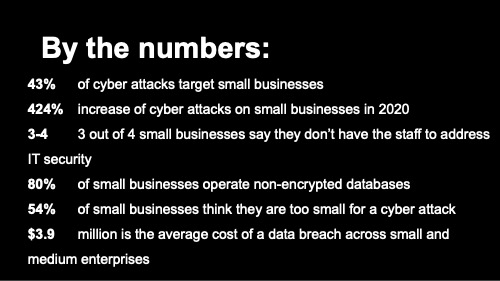
43% of cyber attacks last year targeted small businesses.
The reason is, you’re easier to get into than a Procter and Gamble, Walmart, or a Target. It’s way easier to convince someone’s admin at a small business to go by eBay gift cards and scratch off the code on the back and send pictures to that person who’s posing as you.
There was over a 400% increase in cyber attacks on small businesses in 2020
We weren’t the only one stuck at home during a pandemic. Many of the hackers were too, and they started targeting you. Three out of four small businesses say they don’t have the staff to address IT security. They have no idea what exactly to do.
80% of small companies operate non-encrypted databases
Meaning that if somebody walks in and grabs your customer database, they don’t have to have a key or password to enter.
It would be best if you thought about that because what’s coming from the standpoint of privacy law and data is the law that got enacted in California will head east, and we need to be ready for it.
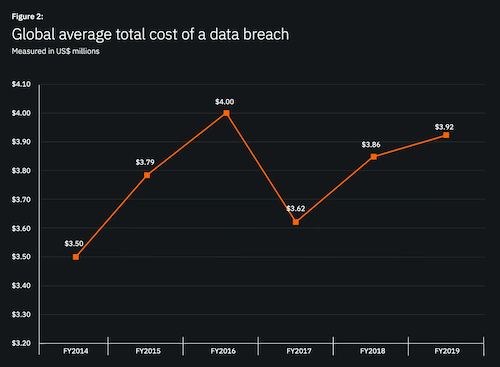
54% of small businesses think they’re too small for a cyberattack
Who’s interested in little old me? Well, the people who realize that it’s easy to get into your business and it’s not just a person. They often set up systems to hunt down porous companies, and if you’re easy to get into, they’ll find you. This number is the one small business need to be most concerned with.
This number can be much more significant with different-sized businesses.
$3.9 million is the average cost of a data breach across small and medium enterprises.
It’s very costly. Because what happens is not only do you have to fix what’s broken and firm up your security. Once a data breach has occurred, you have to determine if you owe any fines and who to notify and if there are people who require specific notification? You must pay attention to where your customers are and what data log governs your customers. Understandably, this can be a bit daunting.
Here are some general questions to help know where to start after experiencing a breach and considering to outsource your IT.
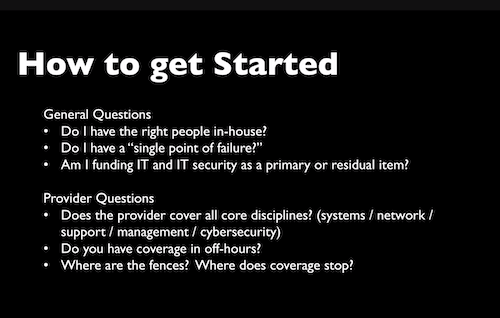
The first question is a critical one.
1.Do I have the right people in-house and do they understand the organization’s technical interface? We find people who bring their consumer mindsets into their business see the latest things that get rolled out, but they’re not keeping up to date with what’s coming—the type of person or people who understand what to prepare for. For example, someone who knows it is time to move to Windows 10 because Microsoft no longer supports Windows seven.
2. Do you have a single point of failure?
If you have the right people in the house, what happens if they get sick or decide they want to pursue another career path?
You may build a business or an IT structure around a single point of failure, but you want to insulate against these scenarios.
Keep in mind, two is one, and one is none.
3. One big question is, are you funding your IT security as a primary or a residual item?
Whether you choose to insource or outsource how you manage your IT is critical because it doesn’t matter which option you choose; if you don’t fund either one of them correctly, it’s still a problem. Most businesses create their budget. They estimate all of the items they’ve must cover from an expense standpoint, and whatever is remaining goes to technology or marketing.
4. Does the provider cover all of the disciplines?
IT is no longer a game where you need to find someone who started working out of their garage and thinks computers are cool. Now it is time to consider hiring or outsourcing licensed engineers who have expertise in technology systems or networks and can support your environment. What types of certifications and accreditation do they have?
5. What are their hours of coverage? Will they charge you more to call them when you’re down at 2 am?
Those are things that are worth asking about. Where does their coverage stop, and where does it start.
Unfortunately, there are specific nuances to this business that even the state likes to get involved with. Would you believe that MSPs have to charge sales tax when installing a computer?
The reality that the rate of change is increasing is exponential – it’s no longer linear, and the only constant is change.
You’re going to disrupt your own company, or someone else will. Focus on what you are going to do long-term. Competition is no longer the multinational overseas companies. It’s the explosion of exponentially empowered entrepreneurs, and you got to ask yourself the question: Does your IT get in the way of you being able to compete with them? Because you’re going to have to be very nimble to do it.
And finally, if you’re dependent on innovation from within your company, you’re going to lose. For too many years, if the only innovation you trust is purely inside your own company, you’re going to run into a lot of challenges and most likely fall behind.
If You Need a Leg Up on Your Competition
If you are a business owner, you understand how competitive it is out there in the open market. Any advantage you attain can mean the difference between prosperity and failure.
Aside from the benefits stated above, an outsourced IT solution can provide advantages such as:
- Data backup and recovery
- Cloud computing services
- Technology Consulting
- Healthcare Optimization
- Cybersecurity Consulting






